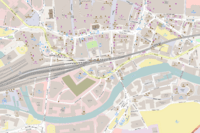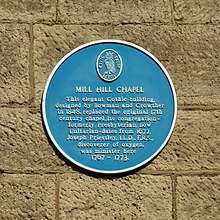Mill Hill Chapel
Mill Hill Chapel is a Unitarian church in Leeds, in the north of England. It is a member of the General Assembly of Unitarian and Free Christian Churches, the umbrella organisation for British Unitarians.[1] The building, which stands in the centre of the city on City Square, was granted Grade II* listed status in 1963.[2][3]
| Mill Hill Chapel | |
|---|---|
| Mill Hill Unitarian Chapel | |
 Mill Hill Chapel Location in Leeds | |
| 53°47′48.15″N 1°32′47.93″W | |
| OS grid reference | SE 29960 33473 |
| Location | Leeds City Square, West Yorkshire |
| Country | United Kingdom |
| Denomination | Unitarianism |
| Previous denomination | Presbyterianism |
| Membership | 27 (2017) |
| Website | millhillchapel |
| Architecture | |
| Functional status | Active |
| Heritage designation | II* |
| Designated | 26 September 1963 |
| Architect(s) | Henry Bowman and J. S. Crowther |
| Architectural type | Church (building) |
| Style | Dissenting Gothic |
| Specifications | |
| Capacity | 120 |
| Administration | |
| District | The Yorkshire Union Of Unitarian And Free Christian Churches |
| Clergy | |
| Minister(s) | Rev'd Jo James |
History
As early as 1674, only a dozen years after the Great Ejection, the Dissenters in Leeds had built a chapel on the main town square. One of the founders was the father of the historian Ralph Thoresby who guided the chapel toward the Dissenter movement which, at Mill Hill Chapel, would become Unitarianism.[4]
During the late 18th century, Mill Hill's sister chapel was the Congregationalist Call Lane Chapel, Leeds. Many of Leeds's leading families such as George William Oates at Low Hall, Potternewton and the Dixon family of Gledhow Hall were heavily involved with both churches at this time. Some local gentry, such as Hans Busk, even "maintained a private Unitarian chaplain" or "Preaching Room" on their own estates.[5][6]
Mill Hill Chapel continued to "penetrate county society"[7] into the 19th century with prominent merchants, industrialists, and politicians such as the Lupton family being its strongest supporters. The chapel became known punningly as "the mayors' nest", as so many mayors and later lord mayors belonged to it.[8] There are memorials to, for example, Francis Garbutt (1847) and John Darnton Luccock (1864).
The Kitson family were also deeply involved in the chapel. William Morris designed a window to Ann Kitson, who died in 1865. Her son James Kitson, 1st Baron Airedale, paid for the extension of the vestry in 1897. After James's death, Archibald Keightley Nicholson created a window in his name, representing the continuation of Christianity.[9]
The Leeds Philosophical and Literary Society drew many of its supporters from the chapel. "There was a careful consciousness of middle-class identity and independence...which combined easily with the utilitarian and scientific interests" of the Mill Hill congregation.[10]
The church guidebook describes the early twentieth century as "a small but politically active and very influential congregation led by the Revd Charles Hargrove and Sir James Kitson".[11] A notable member of the congregation prior to the First World War was Jogendra Nath Sen, who came to study Electrical Engineering at the University of Leeds. He volunteered to fight in September 1914 and joined the Leeds Pals.[12]
Architecture
Mill Hill Chapel sits on the east side of Leeds City Square, in the centre of one of England's most populous, and at the time of its construction most prosperous, cities. Its architects Henry Bowman and J. S. Crowther designed it in the Dissenting Gothic style. The nave still has the original Victorian pews.[2] The architectural sculpture was executed by Robert Mawer.[13]
Leeds Civic Trust recognised its importance in the city with a Blue Plaque.

Ministers
In 1694 Timothy Manlove, who practised as a physician, was invited to be the minister.
The chapel held to orthodox English Presbyterian views at the beginning of the eighteenth century, "but it took a dramatic turn in the direction of heterodoxy with the appointment of Thomas Walker (died 1763) in 1748". He was the uncle-guardian of George Walker, mathematician and activist, who merited inclusion in the Dictionary of National Biography. Joseph Priestley considered Thomas Walker heretical. Many of Walker's sermons were recorded by Joseph Ryder (1695–1768), whose extensive diaries (of 5,000 sermons across Yorkshire) were inherited by his relative Olive Lupton, née Rider (1753-1803).[14]
Joseph Priestley was its minister from 1767 to 1773, and guided the chapel towards Unitarianism. Priestley recommended as his successor William Wood, who was involved in efforts to remedy the political and educational disabilities of Nonconformists under the Test Acts. In addition, during his years there until his death in 1808, he developed considerable expertise as a botanist. His son George William Wood was born there.
Rev Charles Wicksteed was minister for a generation, from 1835 to 1854, and wrote a history of the chapel after he retired. During his time in Leeds, he was president of the Phil and Lit learned society, or, to give it its formal title, the Leeds Philosophical and Literary Society, from 1851 to 1854.[10][15] He co-founded the Leeds Education Society,[16] a precursor to the National Education League. The minister was influential nationally too, jointly editing the Prospective Review for ten years, "the influential voice of the ‘new school’ of English Unitarianism, as against the older tradition of eighteenth-century Priestleyanism"[17] and shaping "the adoption of neo-Gothic architecture" in the new chapels that were being built - what is now called Dissenting Gothic.[18]
From 1855 the minister was Thomas Hincks,[19] a naturalist known for his work on zoophytes and bryozoa. He lost his voice and had to resign in 1869.[20] He devoted his retirement to his scientific work and in 1872 was elected a Fellow of the Royal Society.[21]
References
- "Districts | Unitarians". www.unitarian.org.uk. Retrieved 21 November 2018.
- Historic England. "Mill Hill Chapel, Leeds (1375430)". National Heritage List for England. Retrieved 16 July 2013.
- Chapel History, Mill Hill Unitarian chapel, archived from the original on 24 July 2013, retrieved 16 July 2013
- Mill Hill Chapel website, history page. "Archived copy". Archived from the original on 24 July 2013. Retrieved 16 July 2013.CS1 maint: archived copy as title (link) Accessed 16 July 2013
- Haakonssen, K. (2006). Enlightenment and Religion: Rational Dissent in Eighteenth-Century Britain. Cambridge University Press. p. 50,150,. ISBN 9780521029872. Retrieved 21 July 2020.
A list of Call Lane trustees can be found in the papers of William Lupton and Co at Brotherton Library, University of Leeds....even maintained a private Unitarian chaplain
CS1 maint: extra punctuation (link) - Wolffe, J. (2000). Yorkshire Returns of the 1851 Census of Religious Worship: West Riding (North). Borthwick Publications. p. 150. ISBN 9781904497103. Retrieved 21 July 2020.
Potter Newton - Potternewton Preaching Room (Independant or Congregational) Erected - Altered into a Preaching Room 1847
- Haakonssen, K. (2006). Enlightenment and Religion: Rational Dissent in Eighteenth-Century Britain. Cambridge University Press. p. 150. ISBN 9780521029872. Retrieved 21 July 2020.
...penetrate county society
- page 287. A History of Modern Leeds by Derek Fraser. Manchester University Press, 1980
- Memorial Window to the Late Lord Airedale. Report of the Proceedings at the Unveiling Ceremony ... Together with a Description of the Window. 8 page booklet published by the chapel.
- page 212. A History of Modern Leeds by Derek Fraser. Manchester University Press, 1980
- 1989 Mill Hill Chapel Guidebook, cited in British Listed Buildings
- Leeds Pals Volunteer Researchers. The Leeds Pals: A Handbook for Researchers. The History Press. ISBN 0750989793.
- Leeds Times, Saturday 18 November 1854 p5: The late Mr Mawer", and p.8: "Deaths"
- Kadane, Matthew. “Anti-Trinitarianism and the Republican Tradition in Enlightenment Britain.” Republics of Letters: A Journal for the Study of Knowledge, Politics, and the Arts 2, no. 1 (15 December 2010): http://rofl.stanford.edu/node/68. See also Kadane's book on the diaries, The Watchful Clothier:The Life of an Eighteenth-Century Protestant Capitalist.
- "History". The Leeds Philosophical and Literary Society. Archived from the original on 2 October 2008. Retrieved 13 May 2009.
- page 231 A History of Modern Leeds by Derek Fraser. Manchester University Press, 1980
- Webb, R K (23 September 2004). "Wicksteed, Charles". Oxford Dictionary of National Biography (online ed.). Oxford University Press. doi:10.1093/ref:odnb/49463. Retrieved 21 November 2018. (Subscription or UK public library membership required.)
- The Unitarian Heritage: An Architectural Survey.1986 page 74. Available on the website of British Unitarians here Archived 2014-03-04 at the Wayback Machine.
- page 251. A History of Modern Leeds by Derek Fraser. Manchester University Press, 1980
- Calder, Dale R (October 2009). "The Reverend Thomas Hincks FRS (1818-1899): taxonomist of Bryozoa and Hydrozoa". Arch Nat Hist. England. 36 (2): 189–217. ISSN 0260-9541. PMID 20014505.
- Cornelius, Paul F S (23 September 2004). "Hincks, Thomas". Oxford Dictionary of National Biography (online ed.). Oxford University Press. doi:10.1093/ref:odnb/13337. Retrieved 21 November 2018. (Subscription or UK public library membership required.)
Further reading
- The Unitarian Contribution to Social Progress in England by Raymond Vincent Holt. Lindsey Press, 1937, revised 1952.
- Gentlemen Merchants: The Merchant Community in Leeds, 1700–1830 by Richard George Wilson. Manchester University Press, 1971
External links
| Wikimedia Commons has media related to Mill Hill Unitarian Chapel, Leeds. |